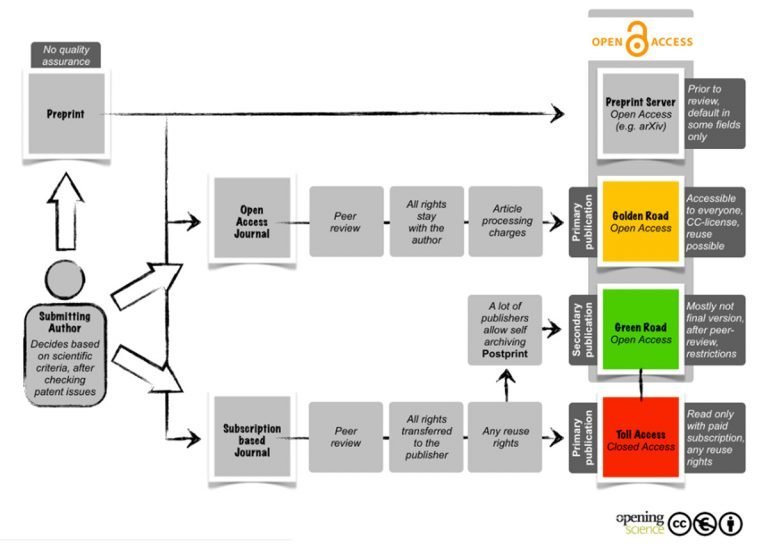Sharing research results has been a traditional practice in the scientific field, facilitated in recent decades by information and communication technologies. The Open Access movement, linked to Open Science, promotes open scientific publishing, so that its contributions are quickly accessible both to researchers and to society as a whole. In this article we review the concept, licenses and strategies to benefit from this type of publication.
What is Open Access?
The term “Open Access” -also known as OA- refers to the open online publication of data and research results, and arose from the Budapest Open Access Initiative in 2002, in which the following benefits are included:
“Removing access barriers to this literature will accelerate research, enrich education, share the learning of the rich with the poor and the poor with the rich, make this literature as useful as it can be, and lay the foundation for uniting humanity in a common intellectual conversation and quest for knowledge.”
Open publication of scholarly content can be done through repositories (institutional, generalist such as Zenodo, or specialized such as the now classic arXiv), departmental, research group or researcher websites or web pages.
It is then, a practice that raises some important questions for researchers: what is the legal protection of materials and papers that are published openly, can they be published openly in scientific journals, and how to reconcile journal publication – and its incentives for research careers – with open publication?
The legal protection of scholarly content published in open access: Creative Commons licensing
By default, the authors of the works have all rights reserved, as long as there is no written transfer of these rights. From the point of view of intellectual property, Open Access is based on a series of licenses, complementary to this general copyright protection regime, which are called Creative Commons licenses. These licenses allow authors to communicate in writing the uses they permit of their works, ranging from the most permissive to the most restrictive:

Publishing in Open Access means not only facilitating access to content, but also helping to use it within the legal margins. For this reason, and despite the fact that researchers have traditionally been able to make use of the right to quote (of ideas; for textual quotations of text, graphics and other protected works, permission is required from the authors or publisher to whom they have assigned rights), a work is only considered to be published in Open Access when it is published under one of these licenses.
Is it possible to publish openly in scientific journals?
The number of journals that allow authors to publish their work openly varies according to the discipline, although in general an increasing number of journals are adopting this model, even traditional ones, as researchers achieve rapid and broad visibility for their work (and the number of citations received for it) and comply with the publication policies required by their funding entities (it is increasingly common to require open publication of the results of publicly funded research).
There are two main types of Open Access (Springer 2018):
- Gold Open Access: Gold Open Access: makes the final (publisher’s) version of an article freely and openly available. Gold OA articles can be published either in OA journals, which publish all their contents in OA, or in hybrid journals, which give authors the option to publish in OA (usually upon payment of a publication fee or APC -article publication charge- as compensation to the journal for the loss to its subscription-based model). Most journals have adopted Creative Commons licenses for open publication.
- Green Open Access: also known as self-archiving, authors publish versions of their work in repositories under Creative Commons licenses. The type of version and the time of publication in the repository will depend on the conditions established by each journal in which the work has been published.
DOAJ (Directory of Open Access Journals) offers an updated list of journals that publish in Open Access. DOAB (Directory of Open Access Books) offers lists of OA books and publishers.

Open Access publishing flow (Sitek y Bertelmann 2014, p. 141)
How to publish Open Access without jeopardizing research incentives?
There is still an opinion among researchers that traditional scientific publication and Open Access publication are mutually exclusive: on the contrary, they are complementary. What strategies can we adopt to benefit from both?
- In research evaluation systems based mainly on the evaluation of the quality of the publication medium over other criteria (as is, to a large extent, the case in Spain, where I am based), we should continue to seek to publish in journals with the highest impact factor in Journal Citation Reports (JCR).
- If these journals offer the possibility of open publication, we will consider the possibility of doing so. Nowadays, some institutions offer help to their researchers by taking charge of the publication fees.
- In case there is no possibility to publish openly in a certain journal or we are not interested in paying publication fees, we can review the conditions of their rights assignment agreements and see what possibilities we have. The SHERPA/RoMEO portal helps us to identify the assignment of rights in each journal. In general, journals allow the publication of pre-prints (author versions, prior to the editing process) on their authors’ websites or web pages or in the repositories of their institutions even before the publication of the paper in their journal. Other journals allow dissemination in OA of the version published by the journal once the embargo period is over (generally one to two years).
Cited references:
SITEK, D. & BERTELMANN, R. (2014). Open Access: A State of the Art. Opening Science. S.l.: Springer, pp. 139-153. ISBN 978-3-319-00025-1. Available at: https://link.springer.com/chapter/10.1007/978-3-319-00026-8_9
